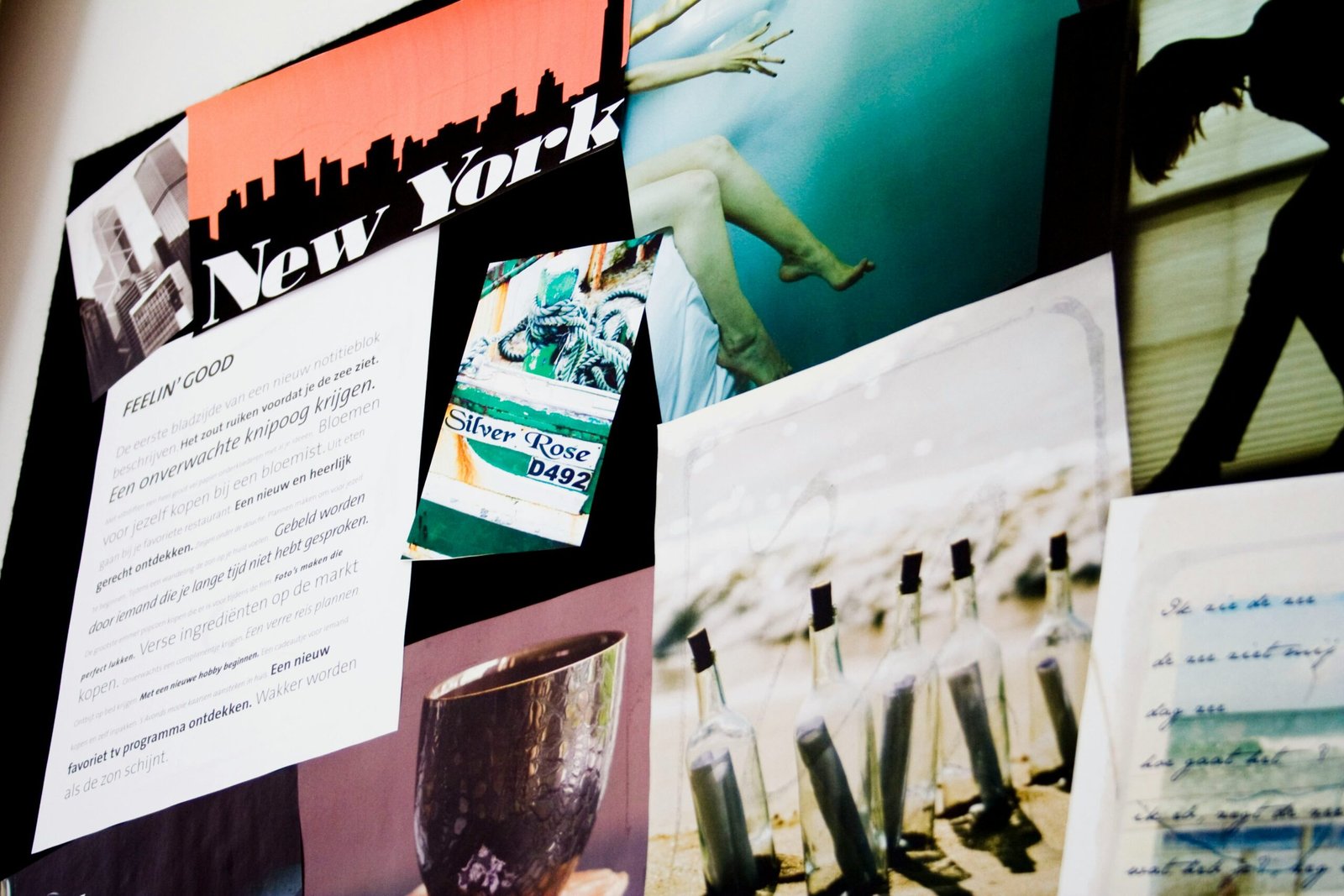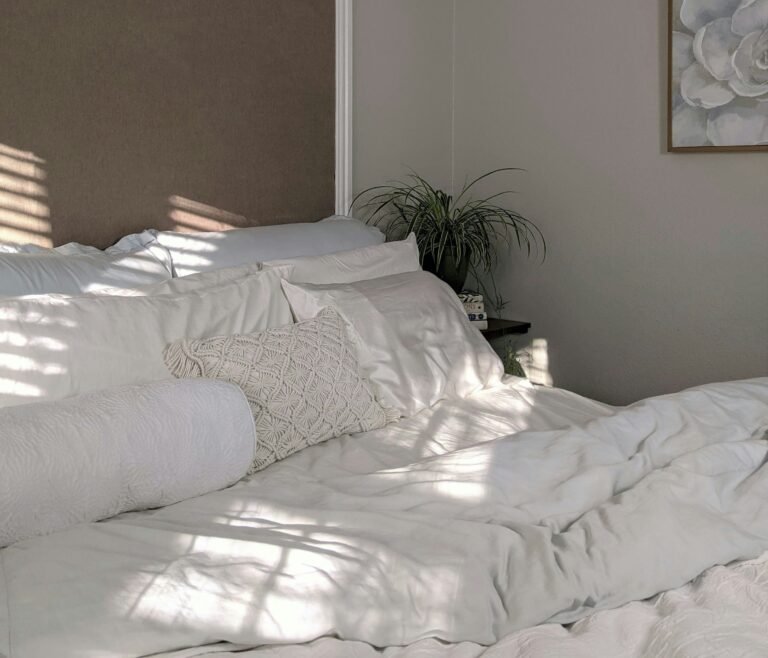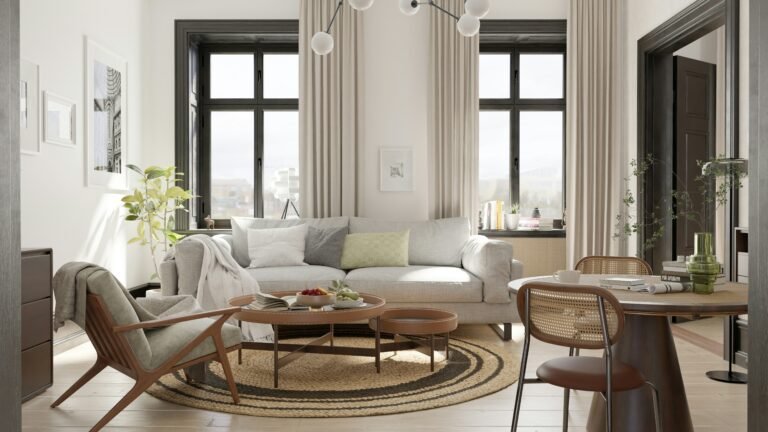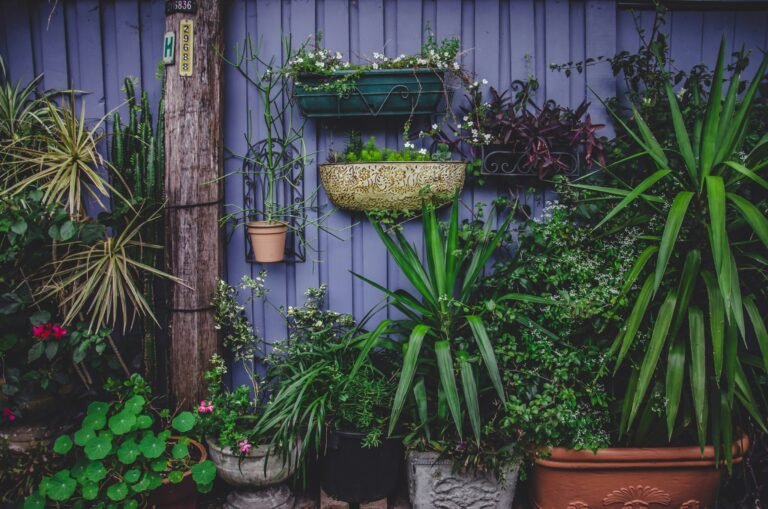Stop me if this sounds familiar:
You’ve got ten tabs open with coffee tables, another five with lighting options, a camera roll full of screenshots, and a Pinterest board that’s more chaos than clarity. You know what you like — in theory. But when you try to picture it all together in your home? It’s a blur.
If that’s you, you’re not alone. Visualising how everything will work together is one of the biggest hurdles when designing or redecorating a space. And that’s exactly where a mood board comes in.
You don’t need a design degree or expensive software to create one. All you need is a clear idea of what you love and a simple way to pull it together. That’s what this article is here to help you with.
You’re about to learn exactly how to create a home mood board — whether digital or physical — that helps you feel more confident, make smarter choices, and finally get the cohesive, intentional look you’ve been chasing. No more guesswork. No more mismatched purchases. Just a home that feels like you.
🖼️ What Is a Mood Board (And Why It Matters)
A mood board is exactly what it sounds like: a visual representation of a mood. In the context of your home, it’s a tool that helps you pull together all your ideas — colours, textures, furniture, lighting, art, flooring — into one place so you can see how it all works together before you spend a penny.
Think of it as your personal style translator. You might like earthy tones, minimalist furniture, and warm lighting. But until you see those elements side by side, it’s hard to tell if they’ll create the vibe you’re after — calm and natural, or cold and empty?
A mood board helps you:
- Spot what doesn’t fit (before you buy it)
- See where you might be doubling up on the same thing (like three tan sofas)
- Notice gaps you haven’t thought about (like art, greenery, or texture)
- Get clear on your design direction — especially if you’re working with others, like a partner or a decorator
It’s not about perfection. It’s about making confident, cohesive choices before you make them real. And once you’ve got that vision in front of you, everything else becomes so much easier — from choosing the right rug to explaining your idea to a contractor.
📌 The Difference Between Pinterest and a Purposeful Mood Board
Pinterest is great — don’t get me wrong. It’s brilliant for collecting inspiration and seeing what’s out there. But here’s the thing: Pinterest is the starting line, not the finish line.
A Pinterest board is often where ideas gather. A mood board is where ideas get filtered.
The difference?
Pinterest is about possibilities. A mood board is about decisions.
When you scroll through Pinterest, you’re grabbing anything that catches your eye — which is totally fine in the early stages. But at some point, you need to stop collecting and start curating. That’s where a mood board becomes your best friend. It forces you to make choices, compare styles, and strip away the things that don’t fit the overall vision.
Here’s a quick comparison:
| Pinterest Board | Mood Board |
| Endless, open-ended inspiration | Clear, focused direction |
| Full of trends and “maybes” | Refined, intentional “yeses” |
| Helps spark ideas | Helps finalise decisions |
| Organised by platform | Organised by your space, style, and needs |
You can (and should) use Pinterest to feed your mood board. Just don’t stop there. If you do, you’ll stay stuck in the cycle of “I like everything… but nothing makes sense together.”
🛠️ How to Create Your Home Mood Board Step by Step
Creating a mood board doesn’t have to be complicated. You don’t need to be a designer or have the “perfect eye.” All you need is a process that helps you go from scattered inspiration to a solid visual plan. Here’s how to do it:
1. Gather Inspiration
Start broad. Scroll Pinterest, Instagram, design blogs, magazines — anything that makes you stop and think “yes, I want that.” Don’t overthink it yet. Just collect what grabs you: colours, furniture, rooms, lighting, vibes.
👉 Hot tip: Look beyond full rooms. Snap or save images of textures, tiles, materials, and colours too. These all contribute to the overall feel.
2. Look for Patterns
Now review what you’ve collected. You’ll start to notice common threads — maybe everything you love is light and airy, or bold and moody. This is where you begin to define your style and weed out the outliers.
Ask yourself:
- Are certain colours repeating?
- Is there a particular material (e.g. natural wood, metal) that keeps popping up?
- Do I lean more minimal or eclectic?
Your answers start shaping your mood board’s foundation.
3. Choose a Format (Digital or Physical)
There’s no right or wrong here — just go with what suits you.
- Digital Mood Board: Tools like Canva, Milanote, or even PowerPoint make it easy to drag and drop images into one place. Super helpful for quick edits and moving things around.
- Physical Mood Board: If you like working with your hands, grab a pinboard or large sheet of card. Print out images, snip magazine clippings, attach fabric swatches or paint samples.
The key is having everything in one space where you can see how it interacts.
4. Curate with Intention
Now you shift from collecting to editing. This is the “make it work together” phase.
- Remove anything that doesn’t fit the vibe
- Keep your board focused and cohesive — not crammed
- Aim for balance in tones, textures, and styles
- Don’t forget to include flooring, lighting, and finishes — they anchor the look
Less is more here. You’re not trying to include everything you like — just the things that work together.
5. Add Texture, Tone, and Detail
It’s easy to get caught up in just the look of a space — but mood is also shaped by texture and material.
- Add samples or photos of wood finishes, tiles, metal fixtures, soft furnishings
- Include tone-on-tone palettes if your style is subtle
- Think: warmth vs coolness, hard vs soft materials, natural vs industrial
This brings depth and dimension to your board, which makes your vision more real — and more actionable.
Once your board feels “right,” it becomes your visual guide. It helps with decisions, stops impulse purchases, and gives you a north star for the rest of your design journey.
🧰 Tools and Apps That Make It Easy
You don’t need fancy design software to create a mood board that works. These tools are easy to use, free or affordable, and perfect whether you’re tech-savvy or not.
🖥️ Canva
Probably the easiest tool for digital mood boards. You can upload images, drag and drop them into a grid, play with colours and text, and rearrange things until it clicks. Tons of free templates too — just search “mood board” and you’ll get a head start.
Why it’s great: User-friendly, flexible, and works on desktop or mobile.
Still useful — especially for gathering ideas. You can create private boards for each room or style, then pull your top picks into your final mood board in Canva or another platform.
Why it’s great: Endless inspiration, easy to organise, good for early brainstorming.
🧱 Milanote
More flexible than Pinterest, more visual than a Google Doc. It feels like a digital pinboard and lets you organise images, text, links, and even colour palettes. Ideal for bigger projects or if you’re working with someone else.
Why it’s great: Great for collaboration and big-picture planning.
🖼️ Google Slides / PowerPoint
Don’t underestimate simple tools. If you’ve got a bunch of images saved, drop them into a slide deck. It gives you a big canvas to move things around and compare.
Why it’s great: Everyone already has it. No learning curve.
🏡 Sample Boards (For Physical Mood Boards)
If you prefer hands-on, collect physical samples — fabric, tiles, paint swatches — and pin them to a board or lay them out on a tray. Stores like B&Q, Homebase, or local paint shops usually offer free or low-cost samples.
Why it’s great: Tactile and realistic. You can feel how things work together in real life.
Use whatever tool fits your style and how you like to work. It’s not about being fancy — it’s about getting clarity.
🧭 How to Use Your Mood Board Once It’s Done
So you’ve got your mood board. It looks cohesive, feels like your style, and has all the elements you love. Now what?
This is where your mood board becomes a tool — not just something pretty to look at.
🛒 Guide Your Shopping Decisions
Before you buy anything, compare it to your board. Does it fit?
This saves you from those “it looked nice online but doesn’t work in my space” moments. Whether it’s a new sofa, a cushion, or a rug, your board gives you a built-in filter: yes, no, or maybe later.
🎯 Stay Focused When You’re Tempted
Design overwhelm is real. One scroll through Instagram or a walk through IKEA can make you question everything. But your mood board is your anchor. It helps you stick to your vision instead of being swayed by trends or impulse buys.
📐 Communicate with Others
If you’re working with a decorator, builder, or even just trying to get your partner on the same page, a mood board makes it easier. It shows your style, your choices, and the overall feeling you’re going for — no need to explain it all with words.
📸 Keep It Handy
Save a photo of your mood board to your phone, or print it out. That way, when you’re out shopping or browsing online, you’ve got it on hand to compare colours, textures, or pieces. It becomes your design compass in real life.
Your mood board is the difference between a space that’s fine and a space that feels intentional. Use it every time you’re making a choice — big or small — and you’ll stay on track without second-guessing yourself.
🚫 Common Mood Board Mistakes (And How to Avoid Them)
Even with the best intentions, it’s easy to veer off course. Here are the most common mood board missteps — and how to dodge them.
❌ 1. Including Too Much
Cramming in every piece you like doesn’t give you clarity — it creates more confusion.
👉 Fix it: Be ruthless. If it doesn’t clearly support your vision, cut it. A tight edit makes a stronger board (and a better room).
❌ 2. Sticking to “Trends” Instead of Your Taste
Just because sage green or boucle is everywhere doesn’t mean it’s you. A mood board should reflect your personal style, not just what’s hot right now.
👉 Fix it: Ask yourself, would I still love this in 3 years? If the answer’s no, let it go.
❌ 3. Forgetting About Function
Aesthetics matter, but so does real life. If your mood board is full of fragile pieces and white upholstery but you’ve got two dogs and toddlers, it’s not practical.
👉 Fix it: Consider how you actually live. Build beauty into functionality.
❌ 4. Not Including Texture or Finish Samples
Design is more than colours and shapes. Texture adds depth and warmth, and finishes (like matte black vs chrome) totally change a space.
👉 Fix it: Add in swatches, textures, or at least photos of materials to make your board feel more grounded.
❌ 5. Using It Once, Then Ignoring It
Your mood board isn’t a one-and-done. It’s a reference tool — use it whenever you’re making a decision. It only works if you keep it in play.
👉 Fix it: Make it visible. Save it to your phone. Stick it on your fridge. Revisit it often.
Avoiding these mistakes keeps your mood board purposeful — and helps you actually enjoy the design process, not just survive it.
🏁 Final Thoughts: Your Space, Your Vision
Designing a home you love doesn’t start with paint swatches or furniture catalogs. It starts with clarity — and that’s exactly what a mood board gives you.
It’s not about making something “Instagram-perfect.” It’s about creating a visual plan that reflects your style, your needs, and the way you actually live. And the best part? Once your mood board is in place, the rest of your design decisions get easier — faster, more confident, and way less second-guessing.
So if your ideas are still floating around in a sea of screenshots and tabs, take an hour to pull them into a board. Edit it. Curate it. Sit with it. You’ll be amazed how much more cohesive and you your space will feel — all because you took the time to plan it visually.
Remember: you don’t have to be a designer to think like one. You just need a mood board.
Alex is the creator of Homely Haven, a space dedicated to simple, stylish ideas for interiors and gardens alike. With a passion for cozy living rooms, inviting outdoor spaces, and practical DIY solutions, Alex shares tips and guides that help turn any house into a true home.
From budget-friendly decorating hacks to weekend garden projects, the goal is always the same: to inspire you to create spaces that feel personal, beautiful, and welcoming. When not writing, Alex is usually rearranging furniture, sketching new garden layouts, or exploring design trends for the next project.








